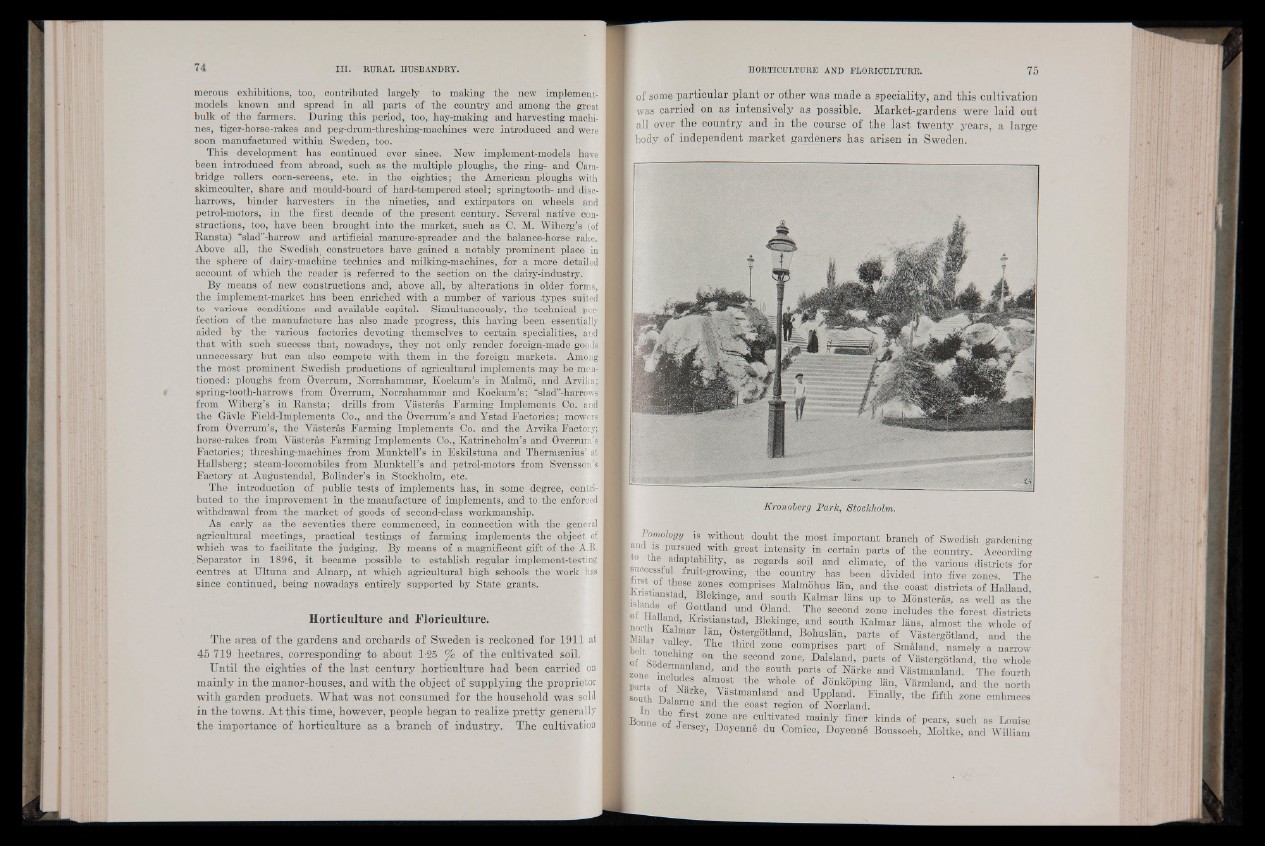
merous exhibitions, too, contributed largely to making the new implement-
models known and spread in all parts of the country and among the great
bulk of the farmers. During this period, too, hay-making and harvesting machines,
tiger-horse-rakes and peg-drum-threshing-machines were introduced and were
soon manufactured within Sweden, too.
This development has continued ever since. New implement-models have
been introduced from abroad, such as the multiple ploughs, the ring- and Cambridge
rollers corn-screens, etc. in the eighties; the American ploughs with
skimcoulter, share and mould-board of hard-tempered steel; springtooth- and dise-
harrows, binder harvesters in the nineties, and extirpators on wheels and
petrol-motors, in the first decade of the present century. Several native constructions,
too, have been brought into the market, such as 0 . M. Wiberg’s (of
Ransta) “slad”-harrow and artificial manure-spreader and the balance-horse rake.
Above all, the Swedish, constructors have gained a notably prominent place in
the sphere of dairy-machine technics and milking-machines, for a more detailed
account of which the reader is referred to the section on the dairy-industry.
By means of new constructions and, above all, by alterations in older forms,
the implement-market has been enriched with a number of various .types suited
to various conditions and available capital. Simultaneously, the technical perfection
of the manufacture has also made progress, this' having been essentiallyaided
by the various factories devoting themselves to certain specialities, and
that with such success that, nowadays, they not only render foreign-made goods
unnecessary but can also compete with them in the foreign markets. Among,!
the most prominent Swedish productions of agricultural implements may be mentioned:
ploughs from Overrum, Norrahammar, Kockum’s in Malmo, and Arvika;
spring-tooth-harrows from Overrum, Norrahammar and Kockum’s; “slad”-harrows
from Wiberg’s in Ransta; drills from Vasteras Farming Implements Oo.land
the Gavle Field-Implements Co., and the Overrum’s and Ystad Factories; mowers
from Overrum’s, the Vasteras Farming Implements Co. and the Arvika Factory;
horse-rakes from Vasteras Farming Implements Co., Katrineholm’s and Overruin’s
Factories; threshing-machines from Munktell’s in Eskilstuna and Thermsenius’ at
Hallsberg; steam-locomobiles from Munktell’s and petrol-motors from Svensson’s
Factory at Augustendal, Bolinder’s in Stockholm, etc.
The i introduction of public tests of implements has,. in some degree, contributed
to the improvement in the manufacture of implements, and to the enffreed
withdrawal from the market of goods of second-class workmanship.
As early as the seventies there commenced, in connection with the general
agricultural meetings, practical testings of farming implements the object of
which was to facilitate the judging. By means of a magnificent gift of the A.B.
. Separator in 1896, it became possible to establish regular implement-testing
■centres at Ultuna and Alnarp, at which agricultural high schools the work has
since continued, being nowadays entirely supported by State grants.
Horticulture and Floriculture.
The area o f th e gardens and orchards o f Sweden is reckoned for 1911 at
45 719 hectares, corresponding to about 1-25 °/o o f th e cultiv a ted soil.
U n til th e e igh tie s o f th e la st century horticulture had been carried on
m a in ly in th e manor-houses, and w ith th e object o f su p p ly in g the proprietor,
w ith garden products. W h a t wa s not consumed for the household wa s sold
in the towns. A t th is time, however, people began to r ealize p r e tty generally
the importance o f horticulture as a branch o f industry . The cultivation
of some particular plant or other was made a speciality, and this cultivation
was carried on as intensively as possible. Market-gardens were laid out
all over the country and in the course of the last twenty, years, a large
body of independent market gardeners has arisen in Sweden.
Kronoberg Park, Stockholm.
Pomology is without doubt the most important branch of Swedish gardening
and is pursued with great intensity in certain parts o f the country. According
to the adaptability, as regards soil and climate, of the various districts for
successful fruit-growing, the country has been divided into five zones. The
nrst of these zones comprises Malmöhus Ian, and the coast districts of TTnllnnH
j anSt? Mnge’ and south Kalmar Ians up to Mönsteräs, as well as the
Lrf TT ’ii ■ ^ottland und Öland. The second zone includes the forest districts
Kristianstad, Blekinge, and south Kalmar läns, almost the whole of
•MäUr ii S ö si ergötland» Bohuslän, parts of Västergötland, and the
[belt +nV\ - 6^* third zone comprises part of Smâland, namely a narrow
of U lM M °? seoond zone’ Dalslaild> parts of Västergötland, the whole
[zone ; ™ anland’ and I I south parts of Närke and Vastmanland. The fourth
[parts rvfC NT-eSi ‘ Q B whole of Jönköping län, Värmland, and the north
K T)nln> ^Vastmanland- and Uppland. Finally, the fifth zone embraces
Dalarne and the coast region of Norrland.
to n n e of P # Z0* e are fdtivated mainly finer kinds of pears, such as Louise
ersey, Doyenné du Comice, Doyenné Boussoch, Moltke, and William